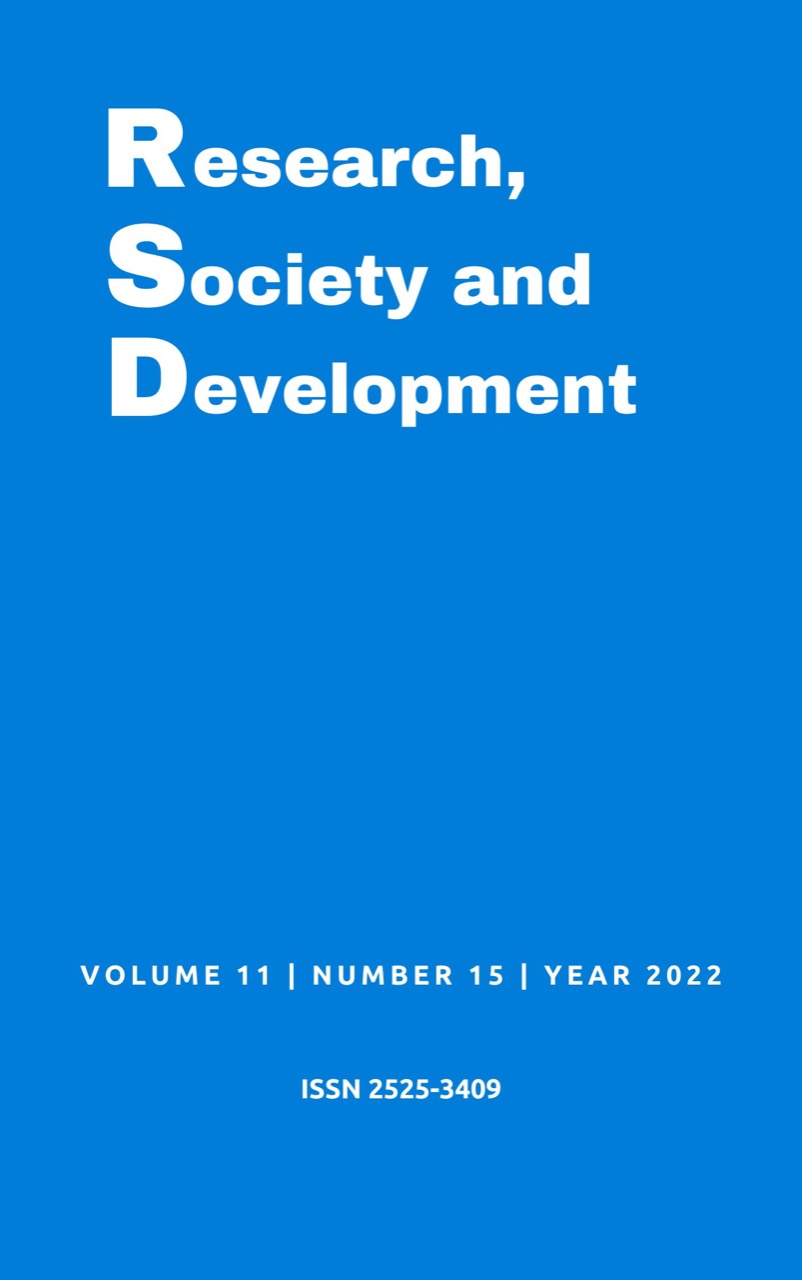Coffin-Siris syndrome: a case report
DOI:
https://doi.org/10.33448/rsd-v11i15.37637Keywords:
Coffin-Siris syndrome; CSS; Fifth digit syndrome; Onychodysplasia of dwarfism; Partial dysgenesis of the corpus callosum; Exome.Abstract
Coffin-Siris syndrome is a genetic condition caused by mutations in genes that are responsible for encoding components of the BAF complex, causing hypoplasia or aplasia of the fifth finger phalanx, coarse facial appearance, developmental delay, intellectual retardation, sparse hair, hypotonia, cardiac and brain abnormalities, among other characteristics. In this sense, the objective of this article is to present a case report on the progression of the diagnosis of Coffin-Siris Syndrome (CSS), where the initial signs and symptoms can be imprecise to make the diagnosis, being necessary to resort to genetic tests for the diagnosis. confirmation of the syndrome.
References
Aravena C, T., Castillo T, S., & Villaseca G, C. (2001). Síndrome de Coffin-Siris: casos clínicos y revisión de la literatura. Revista Chilena de Pediatría, 72(3). https://doi.org/10.4067/s0370-41062001000300007.
Bramswig, N. C., Caluseriu, O., Lüdecke, H.-J., Bolduc, F. V., Noel, N. C. L., Wieland, T., Surowy, H. M., Christen, H.-J., Engels, H., Strom, T. M., & Wieczorek, D. (2017). Heterozygosity for ARID2 loss-of-function mutations in individuals with a Coffin–Siris syndrome-like phenotype. Human Genetics, 136(3), 297–305. https://doi.org/10.1007/s00439-017-1757-z.
Brasil (2022). Doenças raras. Ministério Da Saúde. https://www.gov.br/saude/pt-br/assuntos/saude-de-a-a-z/d/doencas-raras-1.
Bilha, S. C., Teodoriu, L., & Velicescu, C. (2022). Pituitary hypoplasia and growth hormone deficiency in a patient with Coffin-Siris syndrome and severe short stature: case report and literature review. Archive of Clinical Cases, 9(3), 121–125. https://doi.org/10.22551/2022.36.0903.10216.
Figueira, H., Medina, P., Jesus, G., Hanan, A., Júnior, E., & Hanan, S. (2021). Oral findings in Coffin-Siris syndrome: A case report. Revista Portuguesa de Estomatologia, Medicina Dentária E Cirurgia Maxilofacial, 62(1). https://doi.org/10.24873/j.rpemd.2021.03.826.
Interfarma (2018). Doenças Raras: A urgência do acesso à saúde Fevereiro de 2018. https://www.interfarma.org.br/app/uploads/2021/04/doencas-raras-a-urgencia-do-acesso-a-saude-interfarma.pdf.
Kniffin, C. L (2020). Síndrome Coffin Siris. OMIM. Omim.org. https://www.omim.org/about.
Mannino, E. A., Miyawaki, H., Santen, G., & Schrier Vergano, S. A. (2018). First data from a parent-reported registry of 81 individuals with Coffin-Siris syndrome: Natural history and management recommendations. American Journal of Medical Genetics Part A, 176(11), 2250–2258. https://doi.org/10.1002/ajmg.a.40471.
Marconi, M. A., & Lakatos, E. M (2019). Fundamentos de Metodologia Científica. (8ª. ed.): Atlas.
MedlinePlus (n.d). Genetics. Medlineplus.gov. https://medlineplus.gov/genetics/.
Méjécase, C., Hummel, A., Mohand-Saïd, S., Andrieu, C., El Shamieh, S., Antonio, A., Condroyer, C., Boyard, F., Foussard, M., Blanchard, S., Letexier, M., Saraiva, J.-P., Sahel, J.-A., Zeitz, C., & Audo, I. (2018). Whole exome sequencing resolves complex phenotype and identifies CC2D2A mutations underlying non-syndromic rod-cone dystrophy. Clinical Genetics, 95(2), 329–333. https://doi.org/10.1111/cge.13453.
Miranda, V. S. G., & Flach, K. (2019). Aspectos emocionais na aversão alimentar em pacientes pediátricos: interface entre a fonoaudiologia e a psicologia. Psicologia em Estudo, 240. 10.4025/psicolestud.v24i0.45247.
NORD (National Organization for Rare Disorders) (n.d). Coffin Siris Syndrome. Retrieved November 7, 2022, from https://rarediseases.org/rarediseases/coffin-siris-syndrome.
Okamoto, N. “Síndrome Coffin Siris”. Orphanet, 2019. https://www.orpha.net/consor/cgibin/Disease_Search.php?lng=ES&data_id=321&Disease_Disease_Search_diseaseGroup=coffinsiris&Disease_ Disease_Search_diseaseType=Pat&Enfermedad(es)/grupo%20de%20enfermedades=S-ndrome-de-Coffin-Siris&title=S%EDndrome%20de%20 CoffinSiris&search=Disease_Search_Simple.
Schaefer, G. B., & Thompson, J. (2015). Genética Médica: uma abordagem integrada. (3a ed.). Grupo A. AMGH Editora Ltda.
Souza, Í. P. de., Androlage, J. S., Bellato, R., & Barsaglini, R. A. (2019). Doenças genéticas raras com abordagem qualitativa: revisão integrativa da literatura nacional e internacional. Ciência & Saúde Coletiva, 24(10), 3683–3700. https://doi.org/10.1590/1413-812320182410.17822019.
Ordóñez, M. P. T., & Oyervide, J. A. J. (2016). Síndrome de Coffin-Siris. Revista de La Facultad de Ciencias Médicas de La Universidad de Cuenca, 34(3), 69–75. https://publicaciones.ucuenca.edu.ec/ojs/index.php/medicina/article/view/1230.
Vasileiou, G., Vergarajauregui, S., Endele, S., Popp, B., Büttner, C., Ekici, A. B., Gerard, M., Bramswig, N. C., Albrecht, B., Clayton-Smith, J., Morton, J., Tomkins, S., Low, K., Weber, A., Wenzel, M., Altmüller, J., Li, Y., Wollnik, B., Hoganson, G., & Plona, M.-R. (2018). Mutations in the BAF-Complex Subunit DPF2 Are Associated with Coffin-Siris Syndrome. The American Journal of Human Genetics, 102(3), 468–479. https://doi.org/10.1016/j.ajhg.2018.01.014.
Vasko, A., Drivas, T. G., & Schrier Vergano, S. A. (2021). Genotype-Phenotype Correlations in 208 Individuals with Coffin-Siris Syndrome. Genes, 12(6), 937. https://doi.org/10.3390/genes12060937.
Vergano, S. S., & Deardorff, M. A. (2014). Clinical features, diagnostic criteria, and management of Coffin-Siris syndrome. American Journal of Medical Genetics Part C: Seminars in Medical Genetics, 166(3), 252–256. https://doi.org/10.1002/ajmg.c.31411.
Downloads
Published
How to Cite
Issue
Section
License
Copyright (c) 2022 Vanessa Catto Gritti; Murilo Henrique Vieira; Viviane Dorgievicz; Maria Aparecida Marques Habermann; Emyr Hiago Bellaver

This work is licensed under a Creative Commons Attribution 4.0 International License.
Authors who publish with this journal agree to the following terms:
1) Authors retain copyright and grant the journal right of first publication with the work simultaneously licensed under a Creative Commons Attribution License that allows others to share the work with an acknowledgement of the work's authorship and initial publication in this journal.
2) Authors are able to enter into separate, additional contractual arrangements for the non-exclusive distribution of the journal's published version of the work (e.g., post it to an institutional repository or publish it in a book), with an acknowledgement of its initial publication in this journal.
3) Authors are permitted and encouraged to post their work online (e.g., in institutional repositories or on their website) prior to and during the submission process, as it can lead to productive exchanges, as well as earlier and greater citation of published work.

